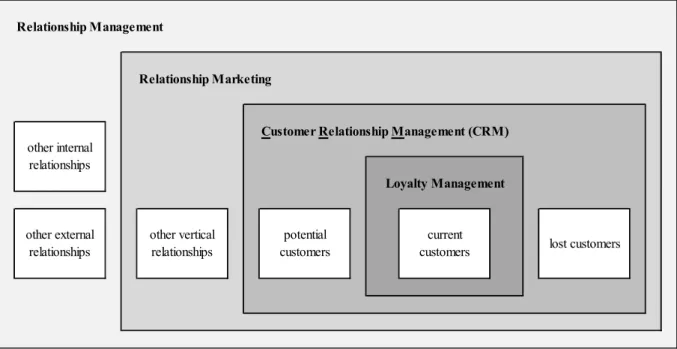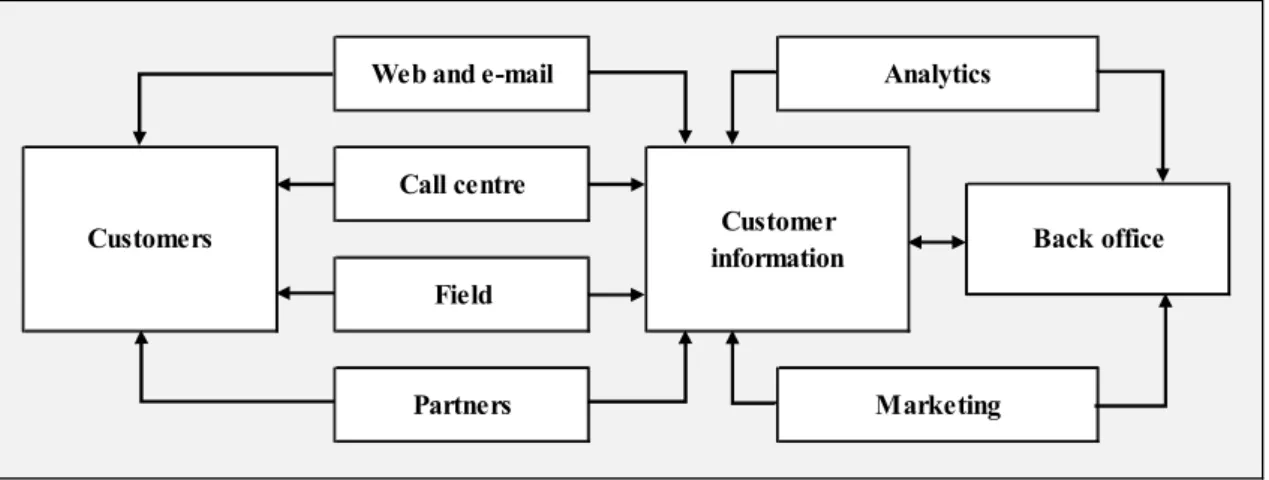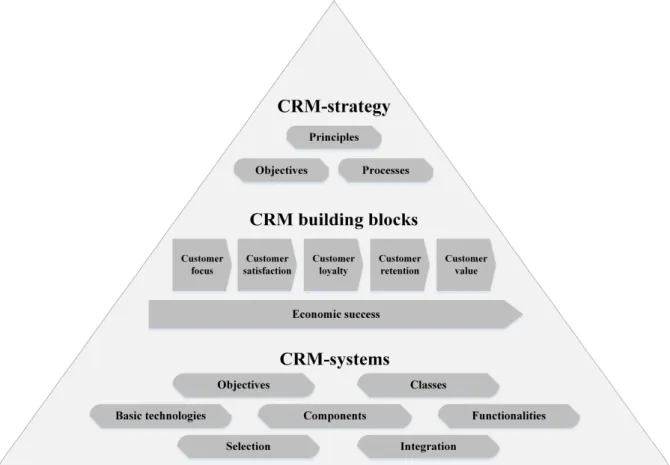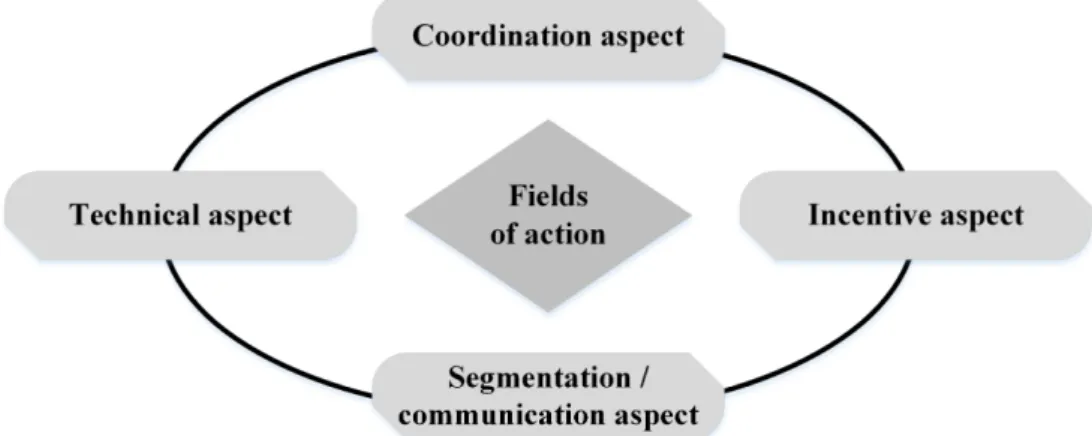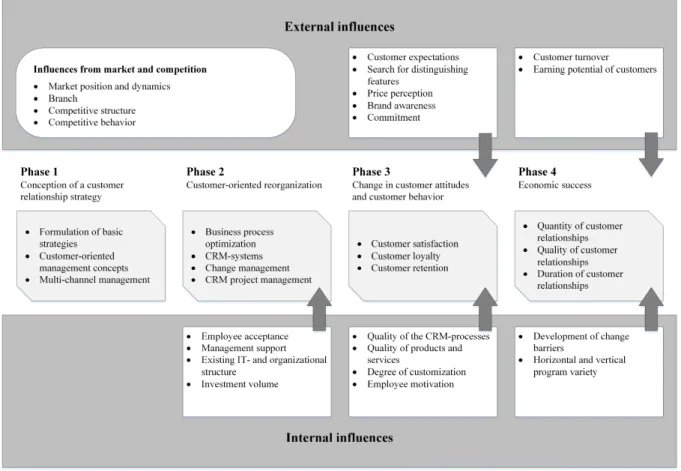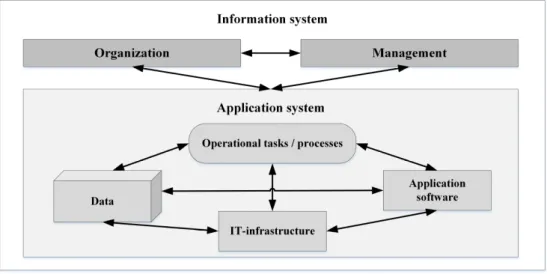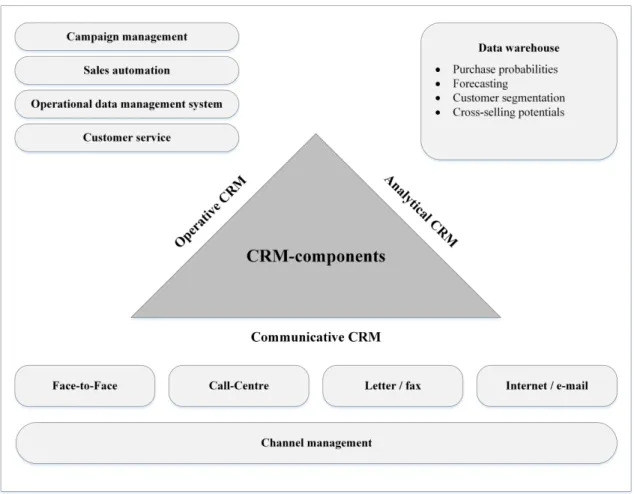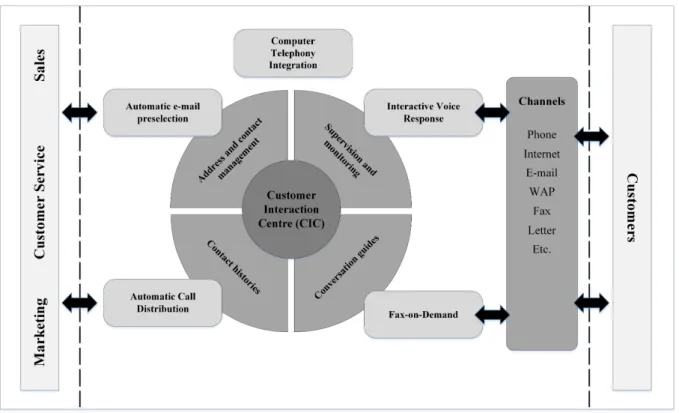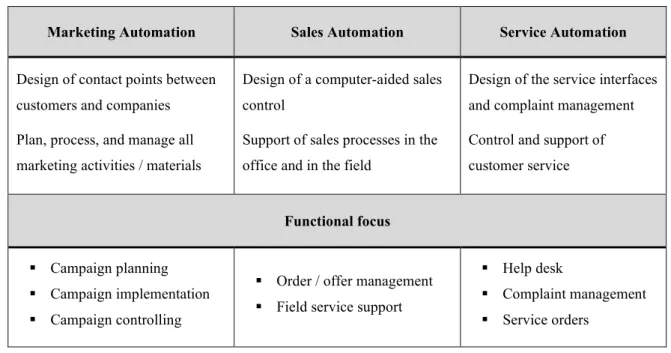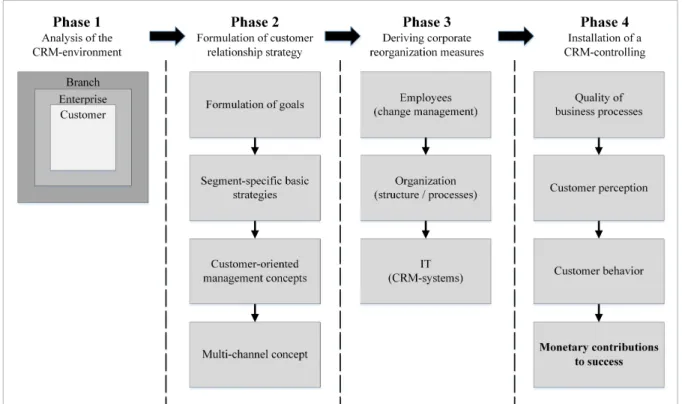DOCTORAL (Ph.D.) DISSERTATION
Ing. Martin A. Moser, MA MSc
University of Sopron Sopron
2021
University of Sopron
Alexandre Lamfalussy Faculty of Economics
Ing. Martin A. Moser, MA MSc
IMPACTS OF CUSTOMER
RELATIONSHIP MANAGEMENT (CRM) ON DEVELOPMENT OF
CORPORATIONS
DOCTORAL DISSERTATION
Supervisor: Prof. Dr. Dr. h.c. Csaba Székely DSc
Sopron, 2021
IMPACTS OF CUSTOMER RELATIONSHIP MANAGEMENT (CRM) ON DEVELOPMENT OF CORPORATIONS
Dissertation to obtain a PhD degree Written by:
Ing. Martin A. Moser, MA MSc Prepared by the University of Sopron
István Széchenyi Doctoral School of Business Economics and Management within the framework of the Joint Cross-Border PhD Programme Supervisor: Prof. Dr. Dr. h.c. Csaba Székely DSc
The supervisor has recommended the evaluation of the dissertation be accepted: yes / no
____________________________
(supervisor signature) Date of comprehensive exam: 20_____ year ___________________ month ______ day Comprehensive exam result: __________ %
The evaluation has been recommended for approval by the reviewers (yes / no)
1. judge: Dr. _______________________ yes / no ____________________________
(signature)
2. judge: Dr. _______________________ yes / no ____________________________
(signature) Result of the public dissertation defence: __________ %
Sopron, 20_____ year ___________________ month ______ day
____________________________
(Chairperson of the Judging Committee)
Qualification of the PhD degree: ____________________
____________________________
(UDHC Chairperson)
ABSTRACT
In markets with highly competitive pressure, like in the packaging industry, companies can only secure their existence by building and assuring long-term competitive advantages via the use of Customer Relationship Management (CRM). The primary goal of CRM is an increase of the corporate value via higher customer satisfaction. One indispensable success factor is the acceptance by its users. The identification of design features of CRM-systems, which have a positive influence on the development and profit of corporations in the packaging industry, would mean a crucial competitive advantage and enable the specifically orientation of the CRM-system on this benefit. This topic has not been discussed so far in the literature for the packaging industry. The lack of empirical contributions to measure the success of CRM- systems contrasts with the great interest in practice and encourages the desire to close this gap.
The overall goal of this doctoral thesis is the identification of design features and prerequisites for a CRM-system, which contribute to an increase in sales and the overall development of corporations in the packaging industry. Particular attention is paid to the identification of requirements of a CRM-system that contribute to an increase in the acceptance of the users. The identified criteria can be used for further CRM-implementations to ensure a proper usage and approval, and furthermore the achievement and assurance of the intended purpose of a holistic CRM-approach. The theoretical part of this thesis is based on an extensive literature research. The case study has been chosen as the overall research design, which allows an intensive examination of the research material, whereby more extensive and complex results can be derived. The data collection of the qualitative research will be done by means of guideline-based and problem-centred interviews and the material will be analysed using the content analysis. A quantitative investigation via an online questionnaire is carried out afterwards to empirically check the developed hypotheses, derived from the qualitative research, via a statistics program.
For a positive impact of CRM-systems on the profit and overall development of corporations in the packaging industry, many necessary requirements must be met first. It is important to consider possible problems in advance, and to avoid them accordingly. Only after the creation of these basic prerequisites or framework conditions, a CRM-system can unfold its intended and expected benefits, which positively influence acceptance, efficiency, and increase the profit.
KEY WORDS
Acceptance criteria Competitive advantages
Customer Relationship Management (CRM) Customer Satisfaction
Increase in sales Industry 4.0
Packaging industry
TABLE OF CONTENTS
1. INTRODUCTION ... 1
1.1 Problem statement ... 5
1.2 Objectives ... 6
1.3 Research gap and research questions ... 7
1.4 Methodical approach ... 8
1.5 Thesis structure ... 10
2. LITERATURE REVIEW ... 12
2.1 General observations ... 12
2.2 Distinction of terms ... 13
2.2.1 Relationship Management ... 13
2.2.2 Relationship Marketing ... 13
2.2.3 Customer Relationship Management (CRM) ... 14
2.2.4 Loyalty Management ... 14
2.3 Customer Relationship Management ... 15
2.3.1 Definition ... 15
2.3.2 Competitive advantages ... 20
2.3.3 CRM in B2B-environments ... 20
2.3.4 Implementation of competitive strategies ... 22
2.3.4.1 New customer management ... 22
2.3.4.2 Customer retention ... 22
2.3.4.3 Customer recovery ... 23
2.3.5 Requirements for the implementation of competitive strategies ... 23
2.3.6 Conceptual framework ... 24
2.3.6.1 Conception of a customer relationship strategy (phase 1) ... 25
2.3.6.2 Customer-oriented reorganization (phase 2) ... 25
2.3.6.3 Change in customer attitudes and customer behaviour (phase 3) ... 26
2.3.6.4 Economic success (phase 4) ... 26
2.3.7 Goals of the CRM-approach ... 27
2.3.8 Industry 4.0 and Social CRM ... 30
2.3.9 Summary ... 32
2.4 CRM-systems ... 33
2.4.1 Definition ... 34
2.4.2 Objectives ... 35
2.4.3 Components and functionalities ... 35
2.4.3.1 Communicative CRM ... 36
2.4.3.2 Operative CRM ... 38
2.4.3.3 Analytical CRM ... 39
2.4.4 Organizational prerequisites... 41
2.4.4.1 Customer relationship cycle-oriented personnel policy ... 41
2.4.4.2 Culture ... 42
2.4.4.3 Organization ... 42
2.4.5 Technological prerequisites ... 43
2.4.5.1 Data quality ... 43
2.4.5.2 Use of data ... 44
2.4.5.3 Privacy ... 44
2.4.5.4 Data security ... 44
2.4.5.5 Integration of information systems ... 44
2.4.5.6 Adaptation of the CRM-system ... 45
2.4.6 Instruments and functionalities of CRM-systems ... 45
2.4.7 Implementation of CRM-systems ... 47
2.4.8 Summary ... 49
2.5 Economic effects of CRM ... 51
2.5.1 Effects on corporate success and firm performance ... 51
2.5.2 Customer proximity ... 51
2.5.3 Customer satisfaction ... 52
2.5.4 Customer retention ... 53
2.5.5 Effects on economic value ... 54
2.5.6 Efficiency criteria of CRM-systems ... 55
2.5.7 Summary ... 56
2.6 Acceptance theory ... 58
2.6.1 Definition ... 58
2.6.2 Dimensions ... 59
2.6.2.1 Attitude acceptance ... 59
2.6.2.2 Behaviour acceptance ... 60
2.6.2.3 Interdependencies of attitude and behaviour acceptance ... 61
2.6.3 Acceptance of Business Information Systems ... 62
2.6.4 Acceptance models ... 65
2.6.4.1 Determinants models ... 65
2.6.4.2 Process models ... 69
2.6.5 Influencing factors of acceptance ... 70
2.6.5.1 Technology-related determinants ... 70
2.6.5.2 Management-related determinants ... 71
2.6.5.3 User-related determinants ... 72
2.6.5.4 Organization-related determinants ... 72
2.6.5.5 Task-related determinants ... 72
2.6.6 Summary ... 73
2.7 Packaging industry ... 74
2.7.1 Characteristics ... 74
2.7.2 Particularities ... 76
2.7.3 Summary ... 77
3. METHODOLOGY ... 78
3.1 Objectives ... 78
3.2 Qualitative research ... 78
3.2.1 Survey methodology ... 78
3.2.2 Evaluation methodology ... 80
3.3 Quantitative research ... 82
3.3.1 Survey methodology ... 82
3.3.2 Evaluation methodology ... 85
4. EMPIRICAL STUDIES ... 86
4.1 Qualitative research ... 86
4.1.1 Execution ... 86
4.1.2 Results ... 87
4.1.2.1 Main category: “requirements” ... 89
4.1.2.2 Main category: “benefits” ... 91
4.1.2.3 Main category: “profit” ... 92
4.1.2.4 Main category: “problem” ... 94
4.1.2.5 Main category: “efficiency” ... 95
4.1.2.6 Acceptance of CRM-systems ... 97
4.2 Quantitative research ... 100
4.2.1 Execution ... 100
4.2.2 Results ... 101
5. INTERPRETATION AND DISCUSSION OF RESULTS ... 109
5.1 Main category: “requirements” ... 110
5.2 Main category: “benefits” ... 111
5.3 Main category: “profit” ... 112
5.4 Main category: “problem” ... 113
5.5 Main category: “efficiency” ... 113
5.6 Acceptance ... 114
6. SUMMARY AND CONCLUSION ... 116
7. NEW SCIENTIFIC RESULTS AND FUTURE RESEARCH ... 120
7.1 New scientific results ... 120
7.2 Future research ... 122
8. BIBLIOGRAPHY ... 123
INDEXES ... 138
List of figures... 138
List of tables ... 139
APPENDICES ... 1
Interview guide 1 (German) ... 1
Interview guide 1 (English) ... 2
Interview guide 2 (German) ... 3
Interview guide 2 (English) ... 4
Expert interview guide (German) ... 5
Expert interview guide (English) ... 6
Questionnaire (German) ... 7
Questionnaire (English) ... 10
BIOGRAPHY OF THE AUTHOR ... 1
General information ... 1
Bibliography ... 2
INFORMATION ON SUPERVISOR (CURRICULUM VITAE) ... 4
ACKNOWLEDGMENTS ... 5
1. INTRODUCTION
“A customer is the most important visitor on our premises. He is not dependent on us. We are dependent on him. He is not an interruption in our work. He is the purpose of it. He is not an outsider on our business. He is part of it. We are not doing him a favour by serving him. He is doing us a favour by giving us an opportunity to do so.”
Mahatma Gandhi (1869 – 1948) The importance of consumers in the field of management has played a decisive role for a very long time. Even in the industrial age, corporations developed control systems that supported the effective handling of material and financial funds. The focal point was exclusively on monetary indicators (Chandler, 1977, p. 21). The upheavals from the industrial age to the information age went hand in hand with a new, tougher competition. Intangible assets made more and more of a company's value (Blair, 1995, p. 7). In the age of digitization, more and more new technologies and developments are entering the market. Sales are also affected by these innovations. In order to be competitive as a company and to meet all customer needs, the organization and, among other things, the sales organization must be optimally supported and controlled (Binckebanck and Elste, 2016, p. 48).
A survey by several companies was engaged by the Nolan Norton Institute in 1990. The goal was to strengthen the monetary key figures that were widely used at the time with other, non-monetary, key figures. The study was headed by David P. Norton and scholarly guidance was provided by Robert S. Kaplan. Members of various corporations then came across regularly and evolved an advanced model for performance measurement. At the beginning, an examination of case studies of available systems for performance measurement took place. In doing so, a procedure was discovered, which has been using a company scorecard since 1987 that supports financial indicators with non-monetary ones (Schneiderman, 1986-1992). Arthur M. Schneiderman then established the basis for the scorecard. Throughout this period, the approach was expanded into a Balanced Scorecard (BSC), when it was noticed that a match between diverse key figures (e.g. performance and result-oriented measures) was required. Key performance benchmarks were nearly solely monetary ones, while the recently enclosed indicators had a non-monetary nature. They are further known as drivers of performance.
External and internal targets are also supposed to be in balance, which is represented by the four assorted frames of reference. The financial and customer perspective is to be considered in counterbalance with the process and development perspective. The investigation was
completed end of 1990 and a summary was issued two years later entitled “The Balanced Scorecard – Measures that Drive Performance” in the Harvard Business Review (Kaplan and Norton, 1992, p. 4).
Subsequently, the relevant main key figures were determined from the corporate strategy.
To achieve this, the strategy was broken down to key success factors (“top-down reflection”).
The study leaders published the results in a succeeding paper called "Putting the Balanced Scorecard to Work" (Kaplan and Norton, 1997, p. 21). This important measurement of performance now had to be inserted in a system for performance measurement. The BSC needs to state the strategy of the corporation in order to create organization-wide clearness and transparency. This shaped the foundation for associating the strategic business unit with the present strategy and vision and should be a vital characteristic for its positive result. An important perspective of the BSC is the customer perspective, in which the focus lies on identifying the market and customer elements on which the competitiveness should be achieved. Identified customer and market segments are then the source for the financial goals (Kaplan and Norton, 1996, p. 34).
Customer requirements are continuously rising every year, thus also in the packaging industry. A trend to an increased exchangeability of product core services of the suppliers can be observed in this market. The highest potential to generate differentiating competitive advantages lies within the qualitative arrangement of the interfaces to the customer. A differentiation from competitors through appropriate investments in a customer- and service- orientation is therefore getting more and more important (Helmke, Uebel, and Dangelmaier, 2017, p. 5). The continuously decreasing customer loyalty and the disproportionately expensive acquisition of new customers compared to the maintenance of regular customers, represent a further problem for many companies. Therefore, corporations are increasingly forced to a systematic and professional arrangement of their customer contacts. In the packaging industry, the operation of professional Customer Relationship Management (CRM) offers an opportunity to differentiate from the competition. CRM is an organizational attempt to comprehend and control customer behaviour via relevant contacts through all possible touch points to enhance customer acquisition, customer profitability, and customer retention (Swift, 2001, p. 14). Using CRM, companies can identify interesting customers and systematize their business relationships with them. Thus, valuable customers can be satisfied and bound to the company in order to increase customer value. CRM also offers benefits for customers, like individuality,
well-being, and the orientation on needs. This can increase customer satisfaction and loyalty to the company (Federal Ministry of Economics and Technology, 2009, pp. 4-5).
The packaging industry is a fast growing and modernizing industry. A company in this industry is gaining competitive advantages, when it fulfils strategically important activities more effective than its competitors. A possibility to achieve this goal is the usage of CRM.
Customers in the packaging industry include both, end consumers and industrial users. CRM also describes a customer-oriented approach, which tries to win and establish valuable and long- term relationships via the assistance of IT-solutions. It can help to increase profit through cost reductions and sales increases (Stokburger and Pufahl, 2002, pp. 16-17). It is not a temporally limited project or single IT-solution, but a holistic approach and customer-oriented strategy, which needs to be implemented within a continuous and organizational learning process (Hippner and Wilde, 2004, p. 15).
An important prerequisite is the comprehensive and intensive IT-support via CRM- systems to enable the implementation of the overall CRM-strategy. CRM-systems provide members of the workforce with the instruments and facts needed to provide client and vendor understanding and allow the optimization of expenditures on evolving and sustaining profitable connections as well as optimizing possibilities. They help to catalogue data from primary marketing offensives and sales touch points by quoting, ordering, producing, shipping, invoicing, and return goods authorization rounds. They enable users to occupy, handle, and follow all interactions with clients and vendors in one spot (“Customer Relationship Management (CRM) System”, 2018).
The acceptance of the employees is a decisive and mandatory factor for the success of a CRM-system, because it is only as good as the employees who implement and use it (Schüller, 2007, p. 11). Without the acceptance of the employees, the implementation of a CRM-system and the realization of associated benefits are difficult to realize. Due to the widespread use of information technology, numerous authors of sales research are investigating the acceptance of CRM-systems that support sales. Technology acceptance forms the basis of this research (Hildebrand, 2015, p. 13). Since CRM-systems can meet rejection in sales, it is important to ensure the success of such a technology. It is significant to analyse influences and factors on the use and acceptance of CRM-systems that will be used in sales (Homburg, Wieseke, and Kuehnl, 2009, pp. 159-168).
The most common reason for employee resistance is fear, resulting from insecurity. The employees are insecure, and fear being overwhelmed by innovations, the uncovering of weak points, and even the loss of their jobs (Helmke, Uebel, and Dangelmaier, 2017, pp. 280-281).
It is essential that employees do not see the system as an administrative burden, but rather recognize the benefits of the CRM-system, enabling them to better concentrate on their core tasks (Dangelmaier, Uebel, and Helmke, 2004, p. 16).
There is a close connection of the topic Customer Relationship Management to various related important economic disciplines, like e.g. change management, organizational development, and knowledge management.
Change management generally deals with the optimal control of corporate change. This can be proactively initiated in order to successfully defy future challenges, or it arises from an immediate reaction to critical phenomena. Change management should not be linked too strictly to corporate change. The introduction of new technologies and processes in the area of communication, for example through a social intranet, customer management (in the form of a CRM system), Industry 4.0 applications or as part of a new product launch would be examples of processes of change (Lauer, 2019, p. 6).
Organizational development is also a relevant issue for most companies. This results from the fact that companies are growing and new and changed resources are created to cope with the tasks and because the weighting and importance of business areas and models are subject to change. Many companies are constantly faced with the question of a suitable or improved organization. Mostly there are parallel ideas and plans on different hierarchical and organizational levels to further develop the organization (Schifferer and von Reitzenstein, 2018, p. 1). Organizational development through CRM helps to strengthen the sales functions, the bundling of all sales activities in one overall responsibility, the strengthening of product management and the review of management margins (Schifferer and von Reitzenstein, 2018, p.
20).
On the way to Industry 4.0, the creation and exchange of data between machines will continue to increase (“Big Data”). The question arises as to how added value can be generated from this countless data and information. Added value is only created if it is possible to generate new knowledge from data and information. The employees and their knowledge are still the most important success factors for companies. Innovations can only arise based on knowledge.
A company's ability to innovate ultimately determines its competitiveness. This makes it clear how important the systematic use of this resource is for companies. Systematic handling of knowledge is called knowledge management (Kohl, Mertins, and Seidel, 2016, p. 1). Successful knowledge management leads to competitive advantages in fast-changing business environments, like e.g. the packaging industry. Tools for measuring, visualizing, and controlling intangible assets in knowledge management are the basis of current and accurate research. Newly adapted mechanisms are investigated with respect to their sufficiency for the strategic evaluation and development of knowledge bases in organizations (Seyr and Hoffer, 2020, p. 1).
These topics were kept in mind while preparing this thesis and conducting the respective research, but as the main purpose of the doctoral dissertation is the identification of design criteria and prerequisites of a CRM-system to contribute to an increase in sales (and an overall development of the respective corporation), the primary focus has been placed on the topic of CRM and related economic disciplines were only partially dealt with and included to avoid going beyond the possible scope of this work.
1.1 Problem statement
Many corporations are facing situations, where they need a structured CRM-approach due to continuous expansion, growth, and more complex organizational and sales structures (Stokburger and Pufahl, 2002, pp. 16-17). In markets with highly competitive pressure, like in the packaging industry, companies can only secure their existence by building and assuring long-term competitive advantages (Meffert, Pohlkamp, and Böckermann, 2010, pp. 7-8).
The identification of design features of CRM-systems, which have a positive influence on the development and profit of corporations in the packaging industry, would mean a crucial competitive advantage and enable the specifically orientation of the CRM-system on this benefit. This topic has not been discussed so far in the literature for the packaging industry.
One indispensable success factor for the implementation of CRM in an organization is the acceptance by its users or the employees of the company. Without this mandatory necessity, a CRM-system is hard to implement, and the corresponding added value cannot be achieved to the desired and needed extent. In most cases a potential resistance against a CRM-approach by the employees can be explained by uncertainties, which result in being afraid of excessive demand due to new tools and systems, the uncovering of weak points, and even by the fear for
a loss of the workplace. If employees are not convinced by the advantages and benefits of a CRM-system, they will hardly and inaccurately use it, resulting in a decreased data quality (Gomolka, 2003, pp. 1-2). Due to this fact, the acceptance of a CRM-system is considered as a mandatory prerequisite for a positive influence on the development and profit of corporations in the packaging industry. The current literature and data are mentioning many technical requirements and prerequisites for CRM-systems and their respective functionalities and processes, as well as general information about the acceptance of IT-systems. Common requirements for the effective accomplishment of a CRM-system and the acceptance by the employees and users, especially in the packaging industry, can hardly be found.
1.2 Objectives
Anticipating continuously changing customer needs, the identification of market opportunities and differentiation potentials, as well as the exploitation of new markets and target groups, are factors that will strongly decide upon the optimization of value creation (Stokburger and Pufahl, 2002, pp. 16-17).
The overall aim of this doctoral thesis is the identification of design features and prerequisites for a CRM-system, which contribute to an increase in sales and the overall development of corporations in the packaging industry. It is important to illuminate the corresponding management concepts that show the individual phases of the customer relationship and thus enable profitable and customer-oriented processing. The objective is to generate decisive competitive advantages through knowledge of the design features and prerequisites for a CRM-system, which have a positive impact on development and sales, and ensure lasting and profitable customer relationships. As a result, long-term competitive advantages and the existence of the company can be guaranteed (Stokburger and Pufahl, 2002, pp. 16-17).
This doctoral thesis is furthermore dealing with the identification of requirements of a CRM-system that contribute to an increase in the acceptance of the users or employees of corporations in the packaging industry. The identified acceptance criteria can be used for further implementations of CRM-systems to ensure a proper usage and approval, and furthermore the achievement and assurance of the intended purpose of a holistic CRM-approach. The factors influencing the acceptance of CRM-systems by its users will be identified and the goal is to derive a requirement profile for a CRM-system in the packaging industry, which will be
accepted by the employees and applied accordingly. Likewise, their motivation to use the system should increase accordingly.
Within the scope of this thesis, measures are developed based on a representative case study that help corporations in the packaging industry with the introduction of a CRM-system in sales. The focus is on finding out dimensions and factors of acceptance and assessing the influence of sales employees when introducing CRM-systems. It is also important to analyse, in which phase of the introduction of CRM-systems which dimensions of acceptance can be assigned.
1.3 Research gap and research questions
The potentials of a CRM-system with regards to an increase in sales can be achieved, when CRM is considered as an integrated approach, which focuses on a customer orientation and not solely on a product orientation. Besides of a customer-related orientation of the organization, the implementation of a CRM-system also requires the reorientation of different organizational and technological processes. The important and useful functionalities of a CRM- system will be identified within a requirement analysis. It is necessary to select those, which have the highest possible application benefit for the company (Holland, 2004, pp. 25-26).
The primary goal of CRM is always an increase of the corporate value via higher customer satisfaction and customer retention. The lack of empirical contributions to measure the success of CRM-implementations contrasts with the great interest in practice in CRM-concepts and encourages the desire to close this gap. Empirical studies, dealing with methods for the determination of financial CRM-success, have been carried out to answer the question, to what extent the promise of an increase in value could be redeemed. However, these studies haven’t been executed industry-specific and over a broad range of company sizes. The methodological challenges, which have been examined in detail regarding this matter, were only partially solved (Selchert, 2004, p. 27). Varajão and Cruz-Cunha (2016) describe the main motivations for the introduction of CRM-systems in a study that was carried out in Portuguese companies, but do not examine the reasons for a possible impact on sales (Varajão and Cruz-Cunha, 2016, p.
1269). Li and Mao (2012) place the focus of their case study on internal sales management using CRM and the resulting advantages for companies. They also do not describe or focus on possible sales-affecting design features of CRM-systems (Li and Mao, 2012, p. 269).
Concluded research questions:
(1) “Which design features of CRM-systems have an impact on the turnover of corporations in the packaging industry and which general requirements need to be fulfilled?”
(2) “Which are the necessary criteria and recommendations for actions for the acceptance and furthermore the success of CRM-systems by its users to contribute to the overall goal of an increased profitability and development of corporations in the packaging industry?”
1.4 Methodical approach
The focus is not only laying on gaining new customers, but also on the permanent retention of existing customers to the respective corporation. With the help of the methodological approach presented, the research questions will be answered, the hypotheses checked, and the results critically questioned, discussed, and put into a common context with the existing literature.
To be able to answer the research questions, the thesis is split in a theoretical and an empirical part. The theoretical part is based on extensive literature research in books, anthologies, scientific journals, and online resources.
The case study has been chosen as the research design. The case study is characterized by the concentration on a representative single social element as the object of investigation, like individuals or institutions (companies and organizations). Due to the limitation of the research object, the case study allows an intensive examination of the research material, whereby more extensive and more complex results can be derived (Lamnek, 2016, pp. 299-300).
The data collection of the qualitative research will be done via guideline-based and problem-centred interviews. The starting point for the creation of the interview guide and the associated questions will be the data and current understanding from the literature accessible about this subject. The interview guideline will consist of an opening and a primary part. The main idea behind the opening is to adjust to one another in the best possible way, and to quickly depict the significance and benefits of the investigation. In the primary part, questions will be asked regarding potential design features of a CRM-system with a view on increasing sales.
The guide categories used for the evaluation result from the thematic affiliation of the questions from the interview guide as follows: impact on customers, efficient work, experience, cost reduction, importance, turnover and most important characteristics. They are therefore based on the relevant literature summarized in the theoretical part. Since the interviews are partly in German and English, an interview guide in both languages will be created. In order to gain access to the field and a broad range of knowledge, sales employees from all sales regions as well as different hierarchy levels (regional sales manager, key account manager, account manager) of the Pharma Division of the Constantia Flexibles Group, a leading manufacturer of packaging materials, will be interviewed in an empirical setting. The selection criterion for sales employees is that they must deal directly with CRM-systems or CRM-approaches in their daily work. Fourteen employees will be selected for this purpose, who, in order to protect anonymity, are only mentioned with their job title and area of responsibility.
The data collection of the second qualitative research will be also executed via guideline- based and problem-centred interviews, which form the foundation for the empirical study. The advantage of problem-centred interviews is that the problem is determined in advance by the interviewer (Schilling, 2016, p. 5). Since the data evaluation of the second case study will take place within the framework of the structuring content analysis, certain categories for the acceptance of CRM-systems must already be defined in the theoretical part. In the second case study, six sales employees from the Constantia Flexibles Group and three external CRM- experts from providers of CRM-systems on the market will be interviewed. The interviews of the sales staff will be used to determine the needs for the acceptance of a CRM-system.
Interviews with the external CRM-experts are the objective counterpart of the internal interviews and are intended to bring additional specialist and industry knowledge and objectivity. A requirement profile for a CRM-system in the packaging industry will be derived from the results of the qualitative research in order to increase employee acceptance. A criteria catalogue is created from the requirement profile, enabling a response to the second research question.
The third step is a quantitative investigation to empirically check the hypotheses, derived from the qualitative research. The starting point of every data collection is the definition of the investigation unit. The objective is to derive statements from a specific industry (packaging industry). The survey focuses on a business-to-business market, which is characterized by the strong relationship between the sales force and their customers. In order to collect valid data on
the acceptance parameters of CRM-systems and their positive effect on the development and success, the survey is ideal, since this data, which requires a deep and comprehensive insight into the organizational structure of the company, cannot be observed using secondary sources (Bortz and Döring, 2006, pp. 216-220). A pre-test concluded the conception of the questionnaire. The goal of the preliminary study was to check the uniqueness and comprehensibility of the indicators and to ensure the relevance of the content of the indicators from the perspective of the practitioner (Rossiter, 2002, pp. 320-323).
1.5 Thesis structure
This doctoral thesis is split into a theoretical and an empirical part. The theoretical part starts with general observations and a distinction of the terms “Relationship Management”,
“Relationship Marketing”, “Customer Relationship Management (CRM)”, and “Loyalty Management”. After this chapter, the topic of CRM will be discussed in detail and its definition, competitive advantages, characteristics in B2B-environments (business-to-business), the implementation of competitive advantages, the requirements for the implementation of competitive strategies, its conceptual framework, the goals of the CRM-approach, as well as Industry 4.0 and Social CRM, will be explained in more detail.
Then, CRM-systems, their definition, objectives, components and functionalities, the organizational and technological prerequisites, the instruments and functionalities of CRM- systems, and the implementation of CRM-systems are dealt with in more detail.
The next chapter is devoted to the economic effects of CRM. It explains the effects of CRM on corporate success and firm performance, customer proximity, customer satisfaction, customer retention, the effects on economic value, and the efficiency criteria of CRM-systems.
Subsequently, the acceptance theory will be described more in detail with regards to its definition, dimensions, the acceptance of Business Information Systems (BIS), acceptance models, and influencing factors of acceptance.
Then, the characteristics and particularities of the packaging industry are discussed and explained in more detail.
After a description of the methodology of the qualitative and quantitative research, which includes the objectives, survey methodologies, as well as the evaluation methodologies, the execution and results of the qualitative and quantitative research are documented.
Finally, there is an interpretation and discussion of the results with regards to the acceptance and usage of CRM-systems, the performance monitoring of CRM-initiatives, the CRM-impacts on the development of corporations, as well as a summary and a conclusion.
New scientific results and future research form the thematic end of this doctoral thesis.
2. LITERATURE REVIEW
In order to address the objectives, the theoretical background, starting with the basics of CRM and CRM-systems, as well as their economic effects and general information about acceptance theory, will be outlined in detail. The aim is to provide the necessary basic knowledge and the theoretical prerequisites for the subsequent methodological part.
2.1 General observations
The effective and efficient use of CRM-systems is considered as a strategic success factor.
A corresponding supply of information to all people involved in the company must be ensured.
The differentiation of the organization from the respective competition is achieved by providing up-to-date and decision-relevant information. Since markets are subject to constant change, companies must pursue both, a customer and a competitive strategy (Stokburger and Pufahl, 2002, p. 31). Customer-oriented CRM-systems are intended to exploit economic potential in order to increase the corporation's profitability (Buchta, Eul, and Schulte-Croonenberg, 2009, pp. 40-41).
CRM-systems not only aim to reduce costs, but also to increase sales. They help to gain new competitive strength in buyers' markets in times of industry 4.0 (e.g. through automation and optimization of order processes). Customers and prospects should be classified according to their value for the organization and treated accordingly (Hubschneider, 2007, pp. 31-32).
In the discussion about the financial advantages of CRM-systems, the Return on Investment (RoI) emerged as the dominant key figure. Possible increases in sales through up- and cross-selling and through the acquisition of new customers by means of recommendations or better marketing are considered. Successful companies that do not implement CRM-systems will lose their competitiveness compared to those that use them to make their organization efficient and customer-oriented (Schiewe, 2003, pp. 26-27).
Before CRM-systems are discussed in detail, a distinction of terms is given, and the basic knowledge is created by explaining the fundamentals of Customer Relationship Management.
2.2 Distinction of terms
In the literature, terms, such as “Relationship Management”, “Relationship Marketing”,
“Loyalty Management” or “Customer Relationship Management”, are sometimes used synonymously or not clearly marked off from one another. This chapter serves to define the individual terms, shown in figure 1, which illustrates the relationship-oriented marketing terms and separates them accordingly. CRM is only reduced to the relationship with the customer (Leußer, Hippner, and Wilde, 2011, p. 20).
Figure 1: Distinction of terms in CRM
Source: Leußer, Hippner, and Wilde, 2011, p. 20
2.2.1 Relationship Management
Relationship Management describes the engaged and methodical examination, choice, arrangement, outline, and guidance of business connections concerning a broad notion of aims, models, individual actions, and schemes (Diller, 1995, p. 442). This is not limited to customer relationships, but also vertical (e.g. vendor connections), horizontal (e.g. sales groups), lateral (e.g. connections with officials) and internal (e.g. personnel) company communications (Diller and Kusterer, 1988, p. 212).
2.2.2 Relationship Marketing
Relationship Marketing primarily puts attention on the client, but moreover involves connections with vendors and other upstream markets. It therefore forms a part of Relationship
Relationship Management
Relationship Marketing
Customer Relationship Management (CRM)
Loyalty Management other internal
relationships
other external relationships
other vertical relationships
potential
customers current lost customers
customers
Management (Leußer, Hippner, and Wilde, 2011, p. 19). Relationship Marketing is understood to be a strategic marketing concept, in which the alignment of all promotional actions is aimed at creating, expanding, and preserving profitable relationships (Berry, 1983, p. 25). The concentration is no longer on transaction-oriented marketing, where the sole focus lies on gaining new customers, but on relationship-oriented marketing to create long-term, customer- oriented business relationships (Parvatiyar and Sheth, 2001, p. 9).
Better customer information enables targeted differentiation in customer service and more efficient processing of customers over their entire life cycle. This in turn leads to customer- specific cost reductions and revenue increases, and thus to a higher earning power of the client interaction. The profitability of the customer relationship, from whose value and stability – measurable in the form of customer satisfaction and loyalty – the company's use of resources over the entire customer life cycle can be determined as the central success factor of Relationship Marketing (Auer, 2004, pp. 16-17).
2.2.3 Customer Relationship Management (CRM)
CRM has developed out of Relationship Marketing and overlaps with it in many areas.
The focus is exclusively on the design of customer relationships. It thus forms an integral part of Relationship Marketing (Götz, 2006, p. 13). A precise definition of the term is given in chapter 2.3.1.
2.2.4 Loyalty Management
Loyalty Management describes the methodical evaluation, arrangement, accomplishment, and supervision of all dimensions aspired to the current client base with the aim of guaranteeing that these clients preserve the business connection in the time to come. The focus is only on existing customer relationships (Bruhn and Homburg, 2017, p. 8). The acquisition of new customers or customer recovery are not part of Loyalty Management (Götz, 2006, p. 14).
2.3 Customer Relationship Management
Rapidly changing market conditions, such as growing competitive pressure in stagnating markets with mostly interchangeable services and the resulting falling loyalty rates, require organizations in the packaging industry to focus more on CRM. The focus lies on the interactions regarding supply and demand, as well as the long-term maintenance and further development of business relationships. It is a philosophy that does not focus on the respective product, but on the relationship with the customer. All company activities must be systematically planned, carried out, controlled, and adjusted with a view to a profitable customer relationship. In addition to customer satisfaction and customer loyalty, considerations about systematic and individualized management of customer relationships, as well as economic considerations and IT-applications, play a decisive role. The long-term goal is to manage the customer base effectively and efficiently based on a value orientation (Meffert, Pohlkamp, and Böckermann, 2010, pp. 5-6).
The implementation of CRM enables the identification of essential actions and dimensions. Due to the inclusion of the establishment of a solitary impression of the client across every interaction channel on the report of three aspects (relationship introduction, preservation, and completion), it plays a significant part. The management of knowledge across interaction and time channels to coordinate the continuous client relationship methodically is associated with it. Generally, CRM enables corporations to utilize these information and investigation to advocate their perception of how to manage clients. Corporations take advantage of the data in CRM-systems to be able to win new clients, keep current clients, and improve these associations via cross-selling and custom-built communications. The domination of previous know-how about forthcoming client projections, the opposed handling of every client, and the benefit of long-ranging interactions among clients and corporations have developed into central features of CRM for picking, gaining, preserving, and developing customers (Palmatier, Kumar, and Harmeling, 2018, p. 58).
2.3.1 Definition
CRM is the integral handling of an organization’s interaction with its clients. Distribution, communication, and supply policies must be integrated in line with customer requirements.
Client satisfaction is the central measure of CRM-successfulness. It is a sign of client loyalty and ultimately for the long-lasting success of an organization (Helmke, Uebel, and Dangelmaier, 2017, p. 7). In marketing science, this concept is defined in the narrower sense as
an integrated information system and in the broader sense as a comprehensive corporate strategy. CRM focuses on identifying, building up, and securing a profitable customer base and in this way contributes to the optimization of a company's customer portfolio. The profitability of the exchange relationship is the central target of CRM. In addition to the stability and value of the relationship, it also includes the company's efficient use of resources throughout the entire customer relationship life cycle (Sperl, 2016, pp. 41-43).
CRM must be understood as a holistic philosophy, which always represents the relationship to the customer as the starting point of the consideration. It requires the re- orientation of business processes and responsibilities, based on a new customer-oriented corporate strategy. Integrated information systems are needed to support this approach, as only the targeted integration and structuring of all customer-related information can provide a central view and a coordinated strategy for the respective customers of the company (Leußer, Hippner, and Wilde, 2011, p. 18). It is quite demanding to expose a primary or ordinary persuasion regarding CRM in theory and practice. CRM-systems, which will be described later in detail, are part of Information Technology (IT) instruments, supporting various administrative actions from a technological viewpoint. Instead it develops into an increased challenge to universalize what CRM combines when thinking about its correlation with humans, corporations, and procedures (Perna and Baraldi, 2014, p. 57).
When it comes to the question of what exactly is to be understood by CRM, the scientific literature has a wide variety of views, ranging from a relatively narrow interpretation to definitions of CRM that encompass almost all operational functions. It should be noted that the individual definitions partly address very different aspects of CRM (Greve, 2006, p. 15). The term has been evolving over time and several definitions attempted to incorporate the meaning of CRM, as stated and summarized in table 1. Exemplary authors, who define CRM in completely different ways, are Helmke et al. (2017), Bruhn (2016), Leußer et al. (2011), Homburg and Sieben (2008), Götz (2006), and Rapp (2005). The focus varies from information technology concepts to a holistic corporate strategy.
Table 1: Definitions of CRM
Author(s) Focus Definition
Kumar and Reinartz, 2018,
p. 5 Profit
“CRM is the strategic process of selecting customers that a firm can most profitably serve, as well as of shaping interactions between a company and these customers. The goal is to optimize the current and future value of customers for the company.”
Helmke, Uebel, and
Dangelmaier, 2017, p. 7 Customer satisfaction “CRM is a holistic processing of the relationship between a company and its customers, in which the communication, distribution, and offer policy is geared towards customer needs, with customer satisfaction being the central measure.”
Bruhn, 2016, p. 8 Information technology
“CRM is a synonym for a purely IT-concept that is used to establish customer relationships with the help of software, i.e. programs for archiving and processing customer data, analysing, and controlling.”
Glattes, 2016, p. 250 Customer experience
“CRM describes the consistent alignment of a company with its customers and the systematic design of customer relationship processes. The associated documentation and management of customer relationships enables in-depth relationship marketing and is therefore an important component and basis for building customer experience management.”
Rai, 2013, p. 30 Holistic view
“CRM is a continuously updated process of identifying relative value of customers and designing customized company interaction to delight them so that they do not just remain with the company profitably, but also be the company’s ambassador. Full involvement and empowerment of employees and appropriate technology are two essentials for successful CRM.”
Shafia et al., 2011, p. 1107 Holistic view “Customer Relationship Management is defined as an effective tool to achieve the objectives, such as satisfied and loyal customers, and increased market share.”
Leußer, Hippner, and
Wilde, 2011, p. 18 Profit
“CRM encompasses the establishment and consolidation of long-term profitable customer relationships through coordinated, customer-specific marketing, sales and service concepts with the help of modern information and communication technologies.”
Laudon et al., 2010, p. 5 Holistic view
“CRM emphasizes the use of IT for targeted analysis, planning, and makeup of business relationships with individual purchasers/customers. CRM is a management concept, as well as a technological concept that utilizes application systems to support business processes for business relationship management.”
Schawel and Billing, 2009,
p. 61 Profit
“Customer Relationship Management includes the segment-specific support and processing of customers in marketing and sales. This is done based on a detailed understanding of customer segments, which includes customer needs and customer value for one's own company.”
Lambert, 2009, p. 5 Profit “CRM is considered as strategic, process-oriented, cross-functional, and value creating for buyers and sellers and a way of achieving superior financial performance.”
Homburg and Sieben,
2008, p. 502 Holistic view “CRM includes the planning, implementation, control, and adjustment of all company activities to optimize the customer portfolio.”
Bohling et al., 2006, p. 186 Profit
“The practice of CRM is described as the process for achieving a continuing dialogue with customers across all available touch points to offer them customized treatment, based on their expected response to available marketing initiatives, such that the contribution from each customer to overall profitability is maximized.”
Shang and Fen, 2006, p. 2 Holistic view “CRM is a combination of people, processes, and technology that seeks to provide understanding of a company’s customers and to support a business strategy to build long-term, profitable relationships with them.”
Götz, 2006, p. 15 Holistic view “Götz (2006) identified four dimensions of CRM: strategic, procedural, organizational, and technological.”
Rapp, 2005, p. 40 Holistic view “CRM is a scientific concept for personalization with a focus on product and process differentiation.”
Hippner, Martin, and
Wilde, 2001, p. 417 Holistic view
“CRM is a customer-oriented corporate philosophy that, with the aid of modern information technology, attempts to build and solidify profitable customer relationships over the long term by applying comprehensive and differentiated marketing, sales, and service concepts.”
Parvatiyar and Sheth,
2001, p. 13 Holistic view “CRM is a comprehensive strategy and process of acquiring, retaining, and partnering with selective customers to create superior value for the company and for the customers.”
Galbreath, 1998, p. 14 Holistic view
“Activities an enterprise performs to identify, select, acquire, develop, and retain increasingly loyal and profitable customers. CRM integrates sales, marketing, and service functions through business process automation, technology solutions, and information resources to maximize each customer contact. CRM facilitates relationships among enterprises, their customers, business supplies, and employees.”
Source: Author’s table
The previously stated definitions of CRM imply the following:
CRM is a process
CRM requires uninterrupted emendation and updates
CRM needs client value detection
CRM pursues client rapture
CRM-procedures aim at a rewarding interaction with clients
CRM-targets on converting clients to function as an organization’s representatives
CRM-implementations require participation and procuration of employees
CRM requires adequate technological support
Figure 2: Customer Relationship Management (CRM)
Source: Author’s figure
As shown in figure 2, customer interactions must be managed across multiple communication channels, like for example call centres, web applications and e-mails, dealers or partners, and field sales. The coordination and linking of purposes in direct customer processing and those that support the back-office area is significant for success. All customer information must be collected, analysed, and used in a meaningful way accordingly. Numerous corporations also keep various principles of business with several overlapping clients. The defiance lies in making it uncomplicated for clients to do commercial activities in a manner they like or prefer to do it anytime, via any channel, and in every currency or language.
Furthermore, it should be achieved to give them the impression that they are interacting with a solitary corporation that pays attention at all touch points. Finally, CRM should make a directed commonly advantageous profitable interaction with clients possible (Rai, 2013, p. 31).
Customers
Call centre
Field Web and e-mail
Partners
Customer
information Back office
Marketing Analytics
As it can be seen in figure 3, the strategic component of a holistic CRM-approach includes long-term goals and principles. These flow directly into the various main- and sub-processes of the corporation. The CRM-strategy is derived after these guidelines have been adjusted to the respective framework conditions of the organization. As a result, various building blocks that build on one another can be identified that aim at economic success. Based on an entrepreneurial orientation towards the customer, customer satisfaction needs to be achieved through CRM- activities. This creates an incentive for the customer to maintain the business relationship (customer loyalty). The longer the customer can be bound to the company, the higher its value.
This is due to the falling costs of maintaining contacts and the increased consumption of services. CRM-systems represent the technological aspect (Torggler, 2007, p. 5).
Figure 3: Holistic CRM-approach
Source: Torggler, 2007, p. 5
As shown in figure 3, CRM is a holistic concept that contains both, a management and technology component, and is based on the control and coordination of the interactions of a corporation with existing customers, as well as activities that affect potential new customers (Laudon, Laudon, and Schoder, 2010, pp. 533-534).
2.3.2 Competitive advantages
In immensely competitive businesses, the existence of corporations can only be secured by establishing and ensuring long-lasting competitive advantages. In addition to the cost-benefit ratio of an offer perceived by the customer, it is also necessary to consider the competitive component. Due to the usage of CRM, a perceptible advantage must arise for the customer, as well as the supplier, through efficiency- and effectiveness-advantages. On the customer side, this could lead to a risk reduction or a general cost advantage, while the supplier may have a higher intensity of the customer relationship and a resulting long-term business relationship.
The literature distinguishes between cost and price leadership, differentiation by quality, time advantages, and brand preferences, which lead to a unique-selling-proposition (Meffert, Pohlkamp, and Böckermann, 2010, pp. 7-8).
On the one hand, a successful relationship management consists of the customers and the CRM-tools and, on the other, the technologies, employee knowledge, and the customer-oriented corporate structure and culture. Competitive CRM and the efficient implementation of organizational processes enable companies to deliver more value to their customers compared to their competitors by meeting or overcoming individual customer needs (Meffert, Pohlkamp, and Böckermann, 2010, pp. 7-8).
2.3.3 CRM in B2B-environments
The origins of CRM are in the B2B-environment (distribution and procurement logistics), e.g. in business relationships between corporations. Companies that have particularly stable and close collaborations with their clients achieve an increased profitability of relationships than other organizations. The primary causes are the positive effects of partnership customer relationships, which are to be brought about through targeted (CRM-) measures. The literature points out that the design of supplier-buyer relationships in B2B-environments places special demands on supplier companies and that CRM is therefore of importance (Schumacher, 2005, p. 28).
CRM is usually designed as an instrument and collection of tools for guiding salespeople and to support engineers during the development of sales projects, forming suitable business plans, handling client disapprovals, and accommodating after-sales client support (Agrawal, 2003, p. 151). Therefore, CRM-utilizations are considered as a closed-loop setup, focusing at
the client position on a collection of primary issues and features that are critical in terms of time (Ku, 2010, p. 1085).
Typical CRM-databases are designed to equip people in sales with assistance and help for searching, client accomplishment, offer establishment, handling objections, as well as closing and reinforcement. Everything is followed on the foundation of touch points, results, and conclusions with the purpose of driving the proposition forward to a successful completion (Stein, Smith, and Lancioni, 2013, p. 855).
The variety of CRM-data in B2B-environments, like the packaging industry, creates a difficulty in assembling the collected data and information in such a manner that enables a generalization among gatherings of clients. Client-specific demands and procedures make it a challenge to classify customers in a meaningful way. These classifications are therefore often not correct and logical (Narayandas and Rangen, 2004, p. 63). Clients are discovered to be solitary, whereas generalization among them is frequently perceived as preposterous (Laiderman, 2005, p. 64). CRM-systems are often seen as libraries or registers with little more reason than equipping sales staff with factual data for prospective offer establishment or providing supervisors the needed data in the occasion of settlement contradictions, whereas CRM-information and data needs to be structured accordingly to encourage significant longitudinal or cross-sectional evaluation (Zahay, Peltier, and Krishen, 2012, p. 5).
The real benefit of CRM-information lies within an availability of the premise for comprehending the disposition of the interaction among customers and the respective organization. Additional to supporting the determination of the foundation for benefit concept advancement, CRM-data can contribute to an accurate representation of the relationship of the organization and solitary clients or client/market segments, as well as among the whole client foundation. CRM is progressively employed as an ordinary data pool for the organization and its customers. Limited admittance to CRM-data can be allowed to important customers regarding dates for shipment, settlement volumes, acceptance and rejection rates, committed amounts, and cost tendencies. Many vendors are perceiving that a truthfulness that raises partnership also leads to client retention (Achrol and Kotler, 1999, p. 146).
CRM and CRM-systems help to gather relevant and important information about customers to assist in enhancing confidence as well as dedication in handling customers, for developing the organization’s sensitiveness to customer’s support and service requirements, for
decreasing client desertions, and for reducing promotional and other associated expenditures.
The organization’s value generation procedure, starting with primary client exploration directly via settlement redevelopment discussions, can be transformed by the steady endeavour of CRM-information for administrative decision-making (Stein, Smith, and Lancioni, 2013, p.
855).
All information in a CRM-system, related to CRM in general, and further origins of market intelligence, should be available for a broad collection of policymakers in the company (Rigby and Ledingham, 2004, p. 118). Just a bunch of executives in most companies are aware of the accessibility of CRM-data and do not know about its utilization. As soon as executives are exposed to the advantages and practice of CRM-data, it evolves into a precious advantage for the corporation’s decision-making procedures. Consequently, the starting point needs to be the training of those who will be producing the information (sales staff) and who will be utilizing the resulting data for their decision-making goals (executives). The entire profitability of CRM is unfolded by the persistence of information gathering and the adaptability in decision- making (Stein, Smith, and Lancioni, 2013, p. 856).
2.3.4 Implementation of competitive strategies
Based on the market life cycle phases (initiation, growth, maturity, degeneration, and reactivation), three strategic options can be used to implement competitive strategies, which will be explained in more detail.
2.3.4.1 New customer management
As part of the acquisition of new customers, the company either has the option of making targeted use of incentives (e.g. special offers) or convincing them through performance tests and advertising measures. If the strategic direction of the company is more cost-oriented, the price is the decisive criterion for an initial purchase. Acquiring new customers through conviction is increasingly taking place in quality or brand-oriented corporations. The aim is always to expand the customer base or to compensate for natural customer fluctuation (Meffert, Pohlkamp, and Böckermann, 2010, pp. 12-15).
2.3.4.2 Customer retention
Depending on the product or service, the relevance of customer retention depends on various factors (e.g. product useful life, brand loyalty, user and environmental friendliness,
quality, etc.). A distinction can be made between two levels of impact. Firstly, the customer's prevention of a manufacturer or brand change due to a factual bond (e.g. through contracts or system ties), and secondly, the customer's failure to make a change due to a high level of customer satisfaction (emotional connection). In addition, three levels of customer retention are distinguished in the literature: price policy instruments on the first, business relationships based on social ties on the second, and targeted investments in customers on the third level (Meffert, Pohlkamp, and Böckermann, 2010, pp. 12-15).
2.3.4.3 Customer recovery
Customer recovery as the last strategic option for the implementation of competitive strategies focuses either on the emotional recovery of endangered customers or on those customers, who have already been lost. The process of winning back customers must therefore begin before the actual termination (Meffert, Pohlkamp, and Böckermann, pp. 12-15). In the early phases of the market and customer life cycle, primarily contractual, technical, and functional forms of customer loyalty dominate in order to protect against investment risk. Due to the stagnation and regression of the market in later phases of the market and customer life cycle, customer loyalty programs help to maintain competitiveness through their effect on customer recovery (Meffert, Pohlkamp, and Böckermann, 2010, pp. 15-16).
2.3.5 Requirements for the implementation of competitive strategies
Figure 4: Requirements for CRM
Source: Meffert, Pohlkamp, and Böckermann, 2010, p. 23
There are four central prerequisites for the success of CRM and the achievement of multi- dimensional competitive advantages as shown in figure 4. The coordination aspect includes the management of internal and external processes and the creation of the organizational
prerequisites. Business and company units must be coordinated in a way that an overall view of all customers can be generated and used. The incentive aspect is a success-determining feature, which focuses on the attractiveness of customer and supplier perspective. Through an early and on-going integration of customer knowledge, new market entry barriers can be generated and a better differentiation from the competition can be achieved. The customer knowledge that is thus specifically available for innovations can help to fulfil their needs even better. It also helps to build change barriers and emotional ligation. This aspect is characterized using preferred communication media from the customer. The last prerequisite is the technical aspect. This includes IT- and system-requirements, along with the usage of new technologies.
CRM-systems are a possibility for the specific management of customer relationships (Meffert, Pohlkamp, and Böckermann, 2010, pp. 23-24).
2.3.6 Conceptual framework
CRM serves the goal of developing profitable customer relationships and increasing company value (Homburg and Sieben, 2008, p. 503). The framework concept is largely based on a purely economic understanding. For the goal of profitable customer relationships, an increase or stabilization of the existing customer satisfaction is decisive (Leußer, Hippner, and Wilde, 2011, p. 20).
CRM supports the optimization of customer-related business processes with the aim of economic success and the establishment of profitable customer relationships. The focus is on customer value from the corporation's perspective. This is understood to be the contribution of a customer to the achievement of the respective company goals. All customer-related measures need to be based on the customer value from the organization's viewpoint and only those customer groups should be looked after sustainably and intensively with whom a positive contribution margin can be generated (Leußer, Hippner, and Wilde, 2011, pp. 21-23).
Figure 5 describes the CRM-chain of effects. About the process of the chain of effects, it should be noted at the outset that the desired monetary successes often only occur in the medium or long term. A measurable economic impact will therefore take a considerable amount of time.
The result chain is positively or negatively influenced by internal and external factors, which can focus on each individual step (Leußer, Hippner, and Wilde, 2011, p. 21).
